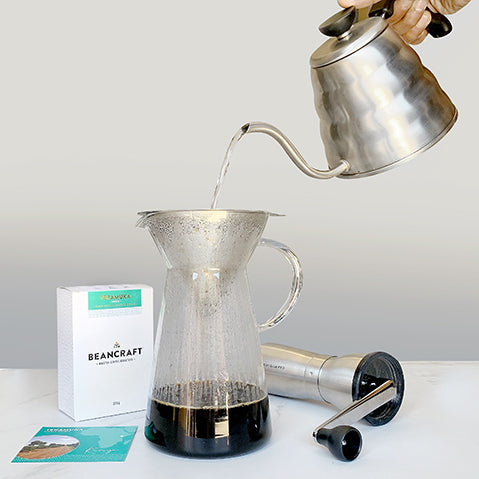Should you buy whole coffee beans or ground coffee? Here at Beancraft HQ, we recommend purchasing whole beans for the ultimate café-quality experience at home.
It may not win for convenience sake, but if you buy whole beans and grind them before you brew your coffee, you will find that the flavour is stronger, and the subtle nuances of your specific bean are more noticeable.
Freshness escapes from ground coffee sooner. The amazing aroma that emanates from fresh grounds are the oils being released from the beans.
As these oils dry up, your beloved coffee loses its superpowers. In fact, after 15 minutes, ground coffee loses about 60% of its aroma, and within days it loses the brightness and depth of flavour.
Exposure to oxygen causes oxidization and the “fading” of your fresh coffee beans.
If you choose to order ground coffee for convenience sake, we recommend ordering just enough and not stockpiling grinds in the panty. This will allow you to enjoy the freshest coffee possible.

Grinding at Home
Choose a good burr grinder such as the Hario Mini Slim Pro. Blade grinders can produce unevenness, so you won't always extract the most from your beans.
These uneven grinds can result in “boulders” and “fines” (large and fine chunks), which will extract at different rates and lead to an unpredictable cup of coffee.
Burr grinders give a more consistent grind and will result in maximum flavour. Next time you place a coffee order, add one of these to the cart.
For a mechanical alternative, several of the staff members here at Beancraft recommend the Breville Smart Grinder Pro (no affiliation, we just think it's an easy-to-use home grinder with some great features).
One Grind to Rule Them All?
Unfortunately, one grind size will not suit all brew applications, so ensure you select the correct grind. Sadly, many a great coffee has been let down by an incorrect grind profile.
The final coffee taste experience will depend on the extraction of your roasted beans; a delicate balance of coffee ratio, time, water temperature, grind size & more.
Various brew methods lend themselves to different grind sizes.
The plunger (French Press) suits a coarser grind, as the extraction time is longer than that of an espresso shot. The pressure and shorter extraction time of an espresso machine will require a finer grind.
Pour-over devices need medium-fine grinds. If you are an Aeropress fan, there is a degree of flexibility, so you can experiment with different variables and recipes to create an ideal cup.
What is Extraction?
Extraction is simply the dissolving of the flavours and other components from roasted and ground coffee beans.
As coffee is brewed, hundreds of unique compounds are extracted from the ground beans into the water, including caffeine (bitter), acids (sweet/sour), sugars (sweetness, as well as viscosity or ‘thickness’), carbs (viscosity, bitterness), and lipids (viscosity).
Up to 28% of a coffee bean are extractable, soluble compounds ready for the taking! The remainder of the bean is cellulosic, fibrous material that makes up the seed structure.
What Does Poorly-Extracted Coffee Taste Like?
Under extraction: Sour, acidic, sometimes salty, and lacking sweetness. This happens when the water isn’t able to pull out enough from the grounds. Below are a few things to try to combat this issue.
- Grind finer - The coarser the grind size, the longer it takes to achieve a balanced extraction. If your setting is too coarse, your water won’t be able to extract everything it needs to.
- Brew longer - Without enough time, the water will be unable to extract the acids, oils and sugars from the coffee. This will generally be evident as a sourness. Add a minute to your brew time and see if this brings back some balance.
- Add water - For pour-over coffee, brewing with insufficient water may lead to an under-extracted coffee, leaving good compounds behind in the grounds. Check your ratios and add water if needed.
Over extraction: Bitter, astringent notes (think unsweetened black tea), tasteless, muted notes. Bitter, dry, ashy, astringent, or strong/intense flavours suggest over-extraction. These flavours occur when water draws too much material out of coffee.
- Grind courser - Try a larger grind to slow down extraction. The larger surface area of the grinds will reduce the extraction rate.
- Brew shorter - Cut down the brew time to lessen the release of undesired bitterness and undesirable notes.

This has been a pretty basic look at how grind affects extraction. There are great resources online for deeper dives into extraction.
Beyond that, keep an eye out on this blog as we explore different brew methods, tips and tricks for your grinder.
We hope this article will improve your brewing experience, and help you take your coffee to the next level.

Looking for some new coffees to experience what the coffee world has to offer? Explore our diverse range of blends and single-origin coffees.


